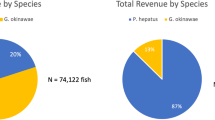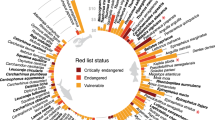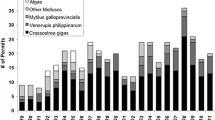Abstract
A major difficulty in managing live organism wildlife trade is often the reliance on trade data to monitor exploitation of wild populations. Harvested organisms that die or are discarded before a point of sale are regularly not reported. For the global marine aquarium trade, identifying supply-chain losses is necessary to more accurately assess exploitation from trade data. We examined quality control rejections and mortality of marine invertebrates (Asteroidea, Gastropoda, Malacostraca, Ophiuroidea) moving through the Papua New Guinea marine aquarium supply-chain, from fisher to importer. Utilizing catch invoices and exporter mortality records we determined that, over a 160 day period, 38.6% of the total invertebrate catch (n = 13,299 individuals) was lost before export. Supply-chain losses were divided among invertebrates rejected in the quality control process (11.5%) and mortality of the accepted catch in transit to, and during holding at, an export facility (30.6%). A further 0.3% died during international transit to importers. We quantified supply-chain losses for the ten most fished species which accounted for 96.4% of the catch. Quality control rejections (n = 1533) were primarily explained by rejections of oversized invertebrates (83.2% of rejections). We suggest that enforceable size limits on species prone to size-based rejections and elimination of village-based holding of invertebrates would reduce losses along the Papua New Guinea supply-chain. This case study underscores that low mortality during international transit may mask large losses along supply-chains prior to export and exemplifies the limitations of trade data to accurately monitor exploitation.





Similar content being viewed by others
References
Ashley S, Brown S, Ledford J, Martin J, Nash AE, Terry A, Tristan T, Warwick C (2014) Morbidity and mortality of invertebrates, amphibians, reptiles, and mammals at a major exotic companion animal wholesaler. J Appl Anim Welf Sci 17:308–321
Association of Zoos and Aquariums (AZA) (2017) The accreditation standards and related policies, 2017 edn. AZA, Silver Spring
Bellwood DR, Hughes TP, Folke C, Nyström M (2004) Confronting the coral reef crisis. Nature 429:827–833
Biondo MV (2017) Quantifying the trade in marine ornamental fishes into Switzerland and an estimation of imports from the European Union. Glob Ecol Conserv 11:95–105
Bloomfield MJ, Schleifer P (2017) Tracing failure of coral reef protection in nonstate market-driven governance. Glob Environ Politics 17:127–146. https://doi.org/10.1162/GLEP_a_00432
Blundell A, Mascia M (2005) Discrepancies in reported levels of international wildlife trade. Conserv Biol 19:2020–2025
Coggins Jr. LG, Catalano MJ, Allen MS, Pine III WE, Waters CJ (2007) Effects of cryptic mortality and the hidden costs of using length limits in fishery management. Fish Fish 8:196–210
Cooke SJ, Schramm HL (2007) Catch-and-release science and its application to conservation and management of recreational fisheries. Fish Manag Ecol 14:73–79
Dandava-Oli L, Sokou P, Wabnitz C (2013) The marine aquarium trade in Papua New Guinea: historical context and current activities. SPC Fish Newslett 141:37–40
Davis MW (2010) Fish stress and mortality can be predicted using reflex impairment. Fish Fish 11:1–11
Dawes J (2003) Wild-caught marine species and the ornamental aquatic industry. In: Cato JC, Brown CL (eds) Marine Ornamental Species: Collection, Culture and Conservation. Iowa State Press, Ames, pp 363–370
de Loriol P (1891) Notes pour server à l'étude des Echinodermes. Memoires de la Société de physique et d’histoire naturelle de Genève. Vol 8 Supplemental 1890, pp 1–31, 3 plates. http://www.biodiversitylibrary.org/item/49961#page/481/mode/1up
Dee LE, Horii SS, Thornhill DJ (2014) Conservation and management of ornamental coral reef wildlife: successes, shortcomings, and future directions. Biol Conserv 169:225–237
Douglas LR, Alie K (2014) High-value natural resources: linking wildlife conservation to international conflict, insecurity, and development concerns. Biol Conserv 170:270–277
EcoEZ (2009) Marine Aquarium Fish Collection Training Manual. EcoEZ Inc., Port Moresby. https://s3.amazonaws.com/sea-smart/Marine-Aquarium-Fish-Collection-Training-Manual.pdf
EcoEZ (2010) Export Trial Facility Management Manual. EcoEZ Inc., Port Moresby. https://s3.amazonaws.com/sea-smart/Facility-Management-Manual.pdf
Ferse SCA, Knittweis L, Krause G, Maddusila A, Glaser M (2013) Livelihoods of ornamental coral fishermen in south Sulawesi/Indonesia: implications for management. Coast Manag 40:525–555
Foster SJ, Vincent ACJ (2005) Enhancing sustainability of the international trade in seahorses with a single minimum size limit. Conserv Biol 19:1044–1050
Fujita R, Thornhill DJ, Karr K, Cooper CH, Dee LE (2014) Assessing and managing data-limited ornamental fisheries in coral reefs. Fish Fish 15:661–675
Guo FC, Woo PTK (2009) Selected parasitosis in cultured and wild fish. Vet Paris 163:207–216
Hall KC, Bellwood DR (1995) Histological effects of cyanide, stress and starvation on the intestinal mucosa of Pomacentrus coelestis, a marine aquarium fish species. J Fish Biol 47:438–454
Hughes TP, Baird AH, Bellwood DR, Card M, Connolly SR, Folke C, Grosberg R, Hoegh-Guldberg O, Jackson JBC, Kleypas J, Lough JM, Marshall P, Nyström M, Palumbi SR, Pandolfi JM, Rosen B, Roughgarden J (2003) Climate change, human impacts, and the resilience of coral reefs. Science 301:929–933
Kinch J (2004) Marine Aquarium Trade, Western Province, Solomon Islands. Marine Aquarium Council, Suva
Kinch J, Teitelbaum A (2010) Proceedings of the Regional Workshop on the Management of Sustainable Fisheries for Giant Clams (Tridacnindae) and CITES Capacity Building. Secretariat of the Pacific Community, Noumea
Leal MC, Vaz MCM, Puga J, Rocha RJM, Brown C, Rosa R, Calado R (2017) Marine ornamental fish imports in the European Union: an economic perspective. Fish Fish 17:459–468
Marine Aquarium Council (MAC) (2001a) Core Collection, Fishing, and Holding International Performance Standard for the Marine Aquarium Trade. Marine Aquarium Council, Suva
Marine Aquarium Council (MAC) (2001b) Core Ecosystem and Fisher Management International Performance Standard for the Marine Aquarium Trade. Marine Aquarium Council, Suva
Marine Aquarium Council (MAC) (2002) MAC Core Standards Interpretation. Marine Aquarium Council, Suva
Marine Aquarium Council (MAC) (2006) Report on Roving Collectors: Case Studies from Indonesia and the Philippines. Marine Aquarium Council, Makati
Madduppa HH, Juterzenka K, Syakir M, Kockzius M (2014) Socio-economy of marine ornamental fishery and its impact on the population structure of the clown anemonefish Amphiprion ocellaris and its host anemones in Spermonde Archipelago, Indonesia. Ocean Coast Manag 100:41–50
Mathews Amos A, Claussen JD (2009) Certification as a conservation tool in the marine aquarium trade: challenges to effectiveness. Turnstone Consulting and Starling Resources
Mies M, Dor P, Güth AZ, Sumida PYG (2017) Production in giant clam aquaculture: trends and challenges. Rev Fish Sci Aquacult 25:286–296
Militz TA, Foale S (2017) The “Nemo Effect”: perception and reality of Finding Nemo’s impact on marine aquarium fisheries. Fish Fish 18:596–606
Militz TA, Kinch J, Foale S, Southgate PC (2016) Fish rejections in the marine aquarium trade: an initial case study raises concern for village-based fisheries. PLoS ONE 11:e0151624
Militz TA, Foale S, Kinch J, Southgate PC (2017) Consumer perspectives on theoretical certification schemes for the marine aquarium trade. Fish Res 193:33–42
Militz TA, Kinch J, Schoeman DS, Southgate PC (2018) Use of total allowable catch to regulate a selective marine aquarium fishery. Mar Policy https://doi.org/10.1016/j.marpol.2017.12.017
Murray JM, Watson GJ (2014) A critical assessment of marine aquarist biodiversity data and commercial aquaculture: identifying gaps in culture initiatives to inform local fisheries managers. PLoS ONE 9:e105982
Nijman V (2010) An overview of international wildlife trade from Southeast Asia. Biodivers Conserv 19:1101–1114
Okemwa GM, Kaunda-Arara B, Kimani EN, Ogutu B (2016) Catch composition and sustainability of the marine aquarium fishery in Kenya. Fish Res 183:19–31
Oksanen J, Blanchet FG, Friendly M, Kindt R, Legendre P, McGlinn D, Minchin PR, O’Hara RB, Simpson GL, Solymos P, Stevens MHH, Szoecs E, Wagner H (2017) Vegan: community ecology package. R package version 2.4-4. https://CRAN.R-project.org/package=vegan
Palomares MLD, Pauly D (2017) SeaLifeBase. www.sealifebase.org. Accessed 3 Aug 2017
Penning M, Reid G, Koldewey H, Dick G, Andrews B, Arai K, Garratt P, Gendron S, Lange J, Tanner K, Tonge S, Van den Sande P, Warmolts D, Gibson C (2009) Turning the tide–a global aquarium strategy for conservation and sustainability. World Association of Zoos and Aquariums, Bern
Pyle RL (1993) Marine aquarium fish. In: Wright A, Hill L (eds) Nearshore Marine Resources of the South Pacific. Information for Fisheries Development and Management. Forum Fisheries Agency and Institute of Pacific Studies, Suva, pp 135–176
Reksodihardjo-Lilley G, Lilley R (2007) Towards a sustainable marine aquarium trade: an Indonesian perspective. SPC Live Reef Inf Bull 17:11–19
Rhyne A, Rotjan R, Bruckner A, Tlusty M (2009) Crawling to collapse: ecologically unsound ornamental invertebrate fisheries. PLoS ONE 4:e8413
Rhyne AL, Tlusty MF, Szczebak JT, Holmberg RJ (2017) Expanding our understanding of the trade in marine aquarium animals. PeerJ 5:e2949
Robinson JE, St. John FAV, Criffiths RA, Roberts DL (2015) Captive reptile mortality rates in the home and implications for the wildlife trade. PLoS ONE 10:e0141460
Rubec PJ, Cruz R (2005) Monitoring the chain of custody to reduce delayed mortality of net-caught fish in the aquarium trade. SPC Live Reef Fish Inf Bull 13:13–23
Rudel TK, Defries R, Asner GP, Laurance WF (2009) Changing drivers of deforestation and new opportunities for conservation. Conserv Biol 23:1396–1405
Schmidt C, Kunzmann A (2005) Post-harvest mortality in the marine aquarium trade: a case study of an Indonesia export facility. SPC Live Reef Fish Inf Bull 13:3–12
Schütz C (2003) Transport losses of CITES-protected and non-protected animal species. BfN–Skripten 90. Bundesamt für Naturschutz (BfN), Bonn
Schwerdtner Máñez K, Dandava L, Ekau W (2014) Fishing the last frontier: the introduction of the marine aquarium trade and its impact on local fishing communities in Papua New Guinea. Mar Policy 44:279–286
Stoner AW (2012) Assessing stress and predicting mortality in economically significant crustaceans. Rev Fish Sci 20:111–135
Teitelbaum A, Yeeting B, Kinch J, Ponia B (2010) Aquarium trade in the Pacific. SPC Live Reef Fish Inf Bull 19:3–6
Thornhill DJ (2012) Ecological Impacts and Practices of the Coral Reef Wildlife Trade. Defenders of Wildlife, Washington
Tlusty MF (2002) The benefits and risks of aquacultural production for the aquarium trade. Aquaculture 205:203–219
Tlusty MF, Rhyne AL, Kaufman L, Hutchins M, McGregor R, Andrews C, Boyle P, Hemdal J, McGilvray F, Dowd S (2013) Opportunities for public aquariums to increase the sustainability of the aquatic animal trade. Zoo Biol 32:1–12
Vagelli A, Burford M, Bernardi G (2009) Fine scale dispersal in Banggai Cardinalfish, Pterapogon kauderni, a coral reef species lacking a pelagic larval phase. Mar Genom 1:129–134
Wabnitz C, Nahacky T (2014) Rapid aquarium fish stock assessment and evaluation of industry best practices in Kosrae, Federated States of Micronesia. Secretariat of the Pacific Community, Noumea
Wabnitz C, Taylor M, Green E, Razak T (2003) From ocean to aquarium. UNEP-WCMC, Cambridge
Williams ID, Walsh WJ, Claisse JT, Tissot BN, Stamoulis KA (2009) Impacts of a Hawaiian marine protected area network on the abundance and fishery sustainability of the yellow tang. Zebra Flavescens Biol Cons 142:1066–1073
Wood E (2001) Global advances in conservation and management of marine ornamental resources. Aquar Sci Conserv 3:65–77
WoRMS (2016) World Register of Marine Species. http://www.marinespecies.org. Accessed 5 Jan 2017
Yamaguchi M (1977) Population structure, spawning, and growth of the coral reef asteroid Linckia laevigata (Linnaeus). Pac Sci 31:13–30
Yan G (2016) Saving nemo–reducing mortality rates of wild-caught ornamental fish. SPC Live Reef Fish Inf Bull 21:3–7
Yeeting BM, Batty M (2010) Review of the marine aquarium trade project in Papua New Guinea. Secretariat of the Pacific Community, Noumea
Acknowledgements
This study was supported by the Australian Center for International Agricultural Research (ACIAR) and the National Fisheries Authority (NFA) as part of ACIAR project FIS/2010/054 “Mariculture Development in New Ireland, Papua New Guinea” led by Paul C. Southgate at the University of the Sunshine Coast. We are particularly grateful to NFA staff for facilitating provision of catch, facility, and export records, and historical documentation of the PNG marine aquarium fishery. We also thank the reviewers and editors who made valuable contributions to this manuscript.
Author information
Authors and Affiliations
Corresponding author
Ethics declarations
Conflict of Interest
The authors declare that they have no conflict of interest.
Electronic supplementary material
Rights and permissions
About this article
Cite this article
Militz, T.A., Kinch, J. & Southgate, P.C. Aquarium Trade Supply-Chain Losses of Marine Invertebrates Originating from Papua New Guinea. Environmental Management 61, 661–670 (2018). https://doi.org/10.1007/s00267-018-1006-9
Received:
Accepted:
Published:
Issue Date:
DOI: https://doi.org/10.1007/s00267-018-1006-9




